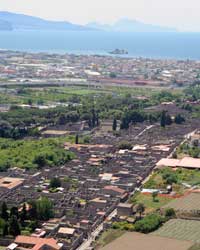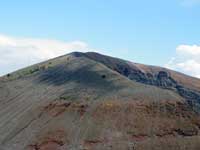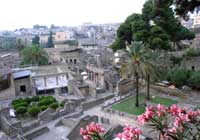“Pyroclastic flows vary in temperature. You can have cold flows and you can have supercharged, exceptionally hot flows. … If it’s cold, you’d suffocate because it’s very fluid — the ash gets in your throat and, effectively, you drowned. Or, if they’re very, very hot, you become incinerated in the blink of an eye.” — Mark Davies, volcanologist

An aerial veiw of Pompeii.
On August 24th, A.D. 79, the people of Herculaneum, a prosperous seaside town in Italy’s Bay of Naples, watched in horror as Mount Vesuvius erupted, hurling a boiling, churning column of gas and ash 10 miles high into the sky. They saw the wind carry the deadly cloud toward the neighboring city of Pompeii, where the hapless citizens suffered a slow and torturous death in the poisonous detritus. It was only a matter of time before Vesuvius would unleash its fury on Herculaneum, killing its citizens in an even more spectacular and gruesome way.
In recent years, the fabled, largely forgotten city of Herculaneum has been re-discovered and, today, archaeologists are scrambling to study and save the fragile site. The film paints a stunning picture of what life was like in the ancient town, and how people ultimately met their horrific deaths there.
“Ironically, Herculaneum’s violent end ensured that the town was suspended in time, and it remains intact 2,000 years later,” said Jared Lipworth, executive producer of SECRETS OF THE DEAD. “Unlike Pompeii — whose fate was a slow burial by ash and pumice — Herculaneum was engulfed by superheated pyroclastic flows of molten rock, mud and gas that actually caused people’s heads to explode. Those flows transformed the living, breathing city of Herculaneum into an incredible time capsule that is even better preserved than Pompeii.”
SECRETS OF THE DEAD looks at Herculaneum, past and present, from every conceivable angle — via aerial views of the town and through the eyes of scientists as they examine such critical minutiae as fig seeds from some of the last meals consumed there before the volcano erupted. Actual footage of erupting volcanoes — including the most recent eruption of Vesuvius in 1944 and pyroclastic flows from the Caribbean island of Montserrat in the 1990s — helps illustrate the power and destructiveness of these cataclysmic events.
The investigation is led by Professor Andrew Wallace-Hadrill, director of The Herculaneum Conservation Project, who knows better than most people that, occasionally, walls do talk. In some parts of Herculaneum, the ancient layers of pyroclastic flows descend as deep as 80 feet, forming walls that hold surprising secrets.

Mt. Vesuvius
The challenges Professor Wallace-Hadrill and his team face are many, including the damage wrought by 18th-century Bourbon treasure hunters, who robbed the site of beautiful mosaic frescos, as well as other precious art and artifacts. But because only a fraction of Herculaneum has been disturbed, the dense lava walls are still giving up other invaluable objects that speak volumes about life there before the disaster.
The discovery of one such object is among many exciting moments as cameras follow the team on a very different kind of treasure hunt. The head of a statue, believed to be of an Amazon warrior woman, is carefully excavated and diligently conserved by experts. The paint is still visible — a rarity in Roman-era statues. Beyond its intrinsic value, the painted head is priceless for what it can reveal about the artistic techniques of the time.
“Here we have a fantastic insight into the big mystery of what a colored statue head was like,” exclaims Professor Wallace-Hadrill, as he inspects the extraordinary find. “You can see how wonderfully delicate the paintwork is. And you can see how it concentrates around the area of the eye. It brings it to life, because for the Ancients, the life resides in the eye — you can see the soul through the eye.”
Unlike Pompeii and virtually every other Roman-era site, Herculaneum boasts a trove of preserved organic material. Delicate household objects examined in the program — from wooden chests and cupboards to textiles and foodstuffs — connect us to daily life in the Roman world, and remind us that the victims of Vesuvius were mundanely and poignantly real.
This point is driven home in one of the most extraordinary moments of the film, when we discover the gruesome truth about Herculaneum’s central mystery: What really happened to its inhabitants when their city was swallowed up by Vesuvius?

A view of Herculaneum, which was buried by volcanic ash when Mount Vesuvius erupted in A.D. 79.
The shocking answer is found in a series of concrete arcades situated at what was once Herculaneum’s original shoreline along the Mediterranean. Dozens of skeletons lie huddled together under the sturdy arches where people gathered most likely in the vain hope of escaping by boat. In one example, a mother bends protectively over her child, as if trying to offer comfort. Beneath her are the tiny bones of a fetus, indicating that she was seven months pregnant. The skeletons show signs of thermal shock from temperatures that were close to one thousand degrees Fahrenheit. Muscles contracted, contorting the bodies, and skin vaporized. Brains boiled and skulls exploded.
Using information and insights gleaned from the site of the doomed city, volcanologists and other experts continually monitor Vesuvius, still an active volcano, for signs of unrest. Many believe that the six million residents who populate the area today, like their ancestors in ancient Herculaneum and Pompeii, are sitting on a time bomb.
Herculaneum Uncovered includes terrifying, rare footage of the last time Vesuvius erupted. While the force unleashed by Vesuvius in 1944 was significantly less powerful than that of the A.D. 79 eruption, the destruction was massive. But, as Professor Wallace-Hadrill reminds us, the human memory is short.
“People have been building right under Vesuvius, right through history – not just the Romans, but millennia before, we know that humans have lived here,” he says. “Vesuvius only erupts very rarely, and people just can’t remember the last time it erupted.”


